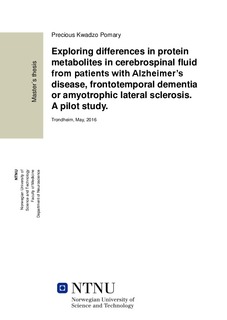| dc.description.abstract | Background: FTD is the second commonest presentation of early onset dementia after AD. While the clinical features, pathophysiology and genetics of FTD are heterogeneous, AD is a more homogenous disease. Despite the superficial differences between these disorders, early onset AD and some variants of FTD are sometimes misdiagnosed due to the overlap between their clinical symptoms. Similarly, the genetic and pathological overlaps between FTD and ALS also hinder the distinction between these disorders. The classical hallmark of neurodegeneration is the aggregation of protein molecules in the brain. This is usually associated with inflammation and consequential increase or decrease in concentrations of structural and inflammatory molecules in the CSF. Based on this, CSF metabolites such as Ttau, P-tau and Aβ-42 have been investigated and are well established as the core biomarkers for AD. However, there is currently no biomarker with comparable diagnostic competence for FTD and ALS. Hence, this research sought to explore whether differences could be found in the CSF concentrations of PGRN, YKL-40, NF-L, α-synuclein, Aβ-40, and Aβ-43 in conjunction with the core AD biomarkers in relation to FTD, ALS and AD. Furthermore, it was hoped that differences might prove useful biochemical markers to distinguish these clinical conditions.
Method: CSF samples from 28 patients with AD, 21 patients belonging to the FTD/ALS spectrum of disorders and 27 age-matched healthy controls were analysed with commercial sandwich ELISA kits. The FTD/ALS spectrum was further divided on a clinical basis into FTD, ALS, PSP and FTD+ALS for the purpose of statistical analysis and comparison. The concentrations of PGRN, YKL-40, NF-L, α-synuclein, Aβ-40, Aβ-43 in addition to the core biomarkers for AD were experimentally determined and analysed with IBM-SPSS version 21.
Result: T-tau/Aβ-42 showed 100% sensitivity and specificity in distinguishing patients with AD from healthy controls. In distinguishing patients with FTD from healthy controls, T-tau/Aβ-42 was the best discriminator with a 100% sensitivity and 93% specificity. Patients with ALS were distinguished from healthy controls by the Aβ-42 ratios of YKL-40 and PGRN. While YKL- 40/Aβ-42 showed 100% specificity and 80% sensitivity, PGRN/Aβ-42 showed 83% sensitivity and 93% specificity. Also, the CSF concentration of T-tau distinguished patients with FTD from those with ALS. However, neither the metabolites nor their ratios could distinguish between patients with AD from patients with FTD.
Conclusion: In this study with CSF, T-tau showed a significant difference between FTD and ALS. Levels of the inflammatory molecules, PGRN and YKL-40, in addition to the structural molecule NF-L, did not distinguish AD, FTD and ALS in this study. However, their ratios were potentially good discriminators in several comparisons. | nb_NO |
